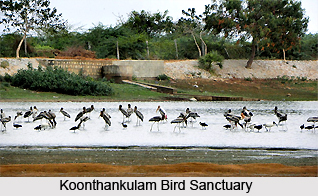 Koonthankulam Birds Sanctuary protected and maintained by the Koonthakulam village community is located in Tirunelveli district in Tamil Nadu. It was declared a protected area in the year 1994. The sanctuary adjoins a small village in Koonthankulam. It is situated 38 km away from Tirunelveli in Tirunelveli Thisaianvilai Road. It is composed of Koonthankulam and Kadankulam irrigation tanks. These are linked by tar road. Koonthankulam Birds Sanctuary is the largest breeding water bird reserve in south India. It attracts various species of birds, almost more than one lakh every year. It covers an area of 129.33 hectares.
Koonthankulam Birds Sanctuary protected and maintained by the Koonthakulam village community is located in Tirunelveli district in Tamil Nadu. It was declared a protected area in the year 1994. The sanctuary adjoins a small village in Koonthankulam. It is situated 38 km away from Tirunelveli in Tirunelveli Thisaianvilai Road. It is composed of Koonthankulam and Kadankulam irrigation tanks. These are linked by tar road. Koonthankulam Birds Sanctuary is the largest breeding water bird reserve in south India. It attracts various species of birds, almost more than one lakh every year. It covers an area of 129.33 hectares.
Koonthankulam Birds Sanctuary is protected by the local people who take keen interest in maintaining the sanctuary. These people live together in complete symbiotic relationship. The birds that migrate to their backyards for the last five generations have been protected. These are regarded as indications of luck. During the summer season the excreta of birds -`guano` is collected by villagers along with silt and use them as fertilizer while irrigating their fields. All the villagers are engaged in protecting the birds, their nests and fledglings. They also have a rescue centre where the fallen chicks are taken and cared till they can fly. An interpretation centre, watch tower, children`s park and dormitory are open for public use throughout the year.
Flora and Fauna of Koonthankulam Birds Sanctuary
The Babul plantation in koonthakulam is the main breeding ground here. Accacia nilotica trees are grown in the tank foreshores by the Social Forestry Division of Forest Department. Koonthankulam Birds Sanctuary is visited by more than 43 water birds both resident and migratory every year especially in the months of January and February. They vacate their nests in the months of July and August after nesting, hatching and nurturing the young chicks. From a long time many large water birds especially Painted stork, Flamingos have been nesting here. There are many other migratory birds who visit the sanctuary like Barheaded Goose, Pintail, Spotted Sand Piper, Green Sand Piper, Green Shank, Coot, White stork, large flamingo, Common Sand Piper, Common Teal and Pallavan. Apart from these there are other birds who visit the sanctuary during January to August of every year like Dabchick or Little Grebe, White Ibis, Grey or Spottedbilled Pelican, Large Cormorant, Spoonbill, Spotbill Duck, Cotton Teal or Pygmy Goose, Little Cormorant, Indian Moorhen, Purple Moorhen, Large Egret, Darter or Snake Bird, Whitebreasted Waterhen, Blackwinged Stilt, Painted Stork, Whitebreasted Kingfisher, Pied Kingfisher, Small king fisher and others.
Koonthankulam Birds Sanctuary is well connected with all modes of transport. The nearest railway station is located at Tirunelveli that is 35 kms away. The nearest airports are located at Madurai at a distance of 200 kms and Trivandrum at a distance of 250 kms.



















